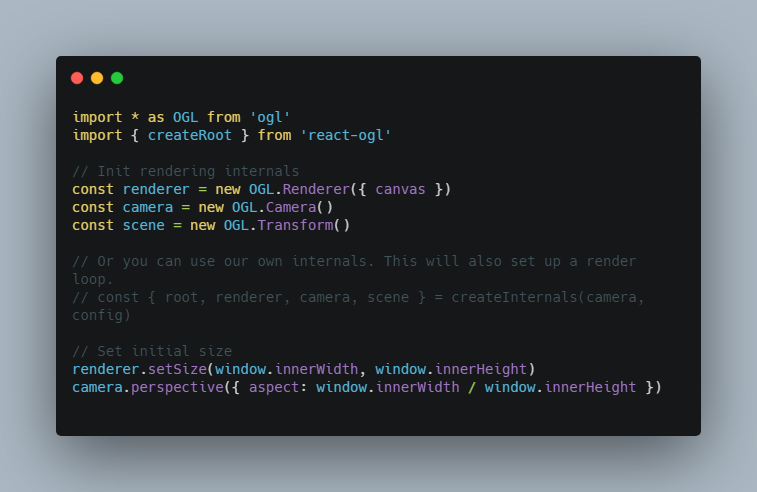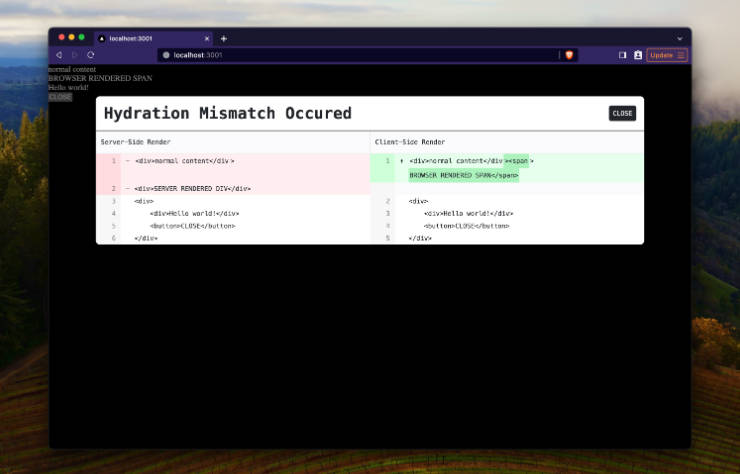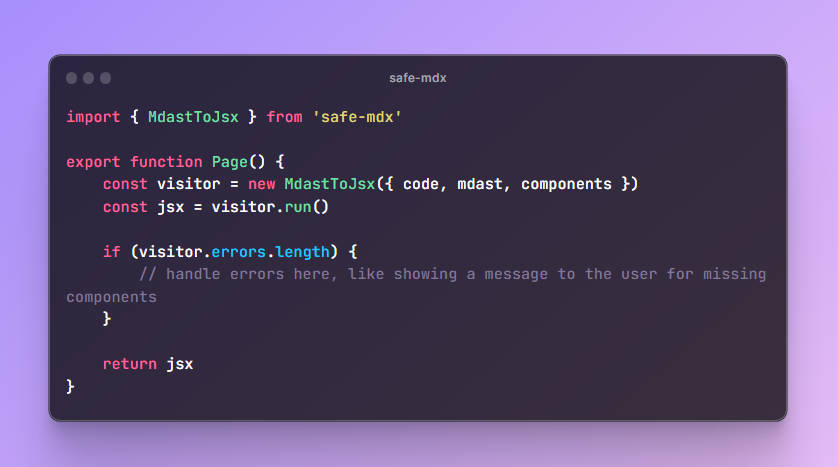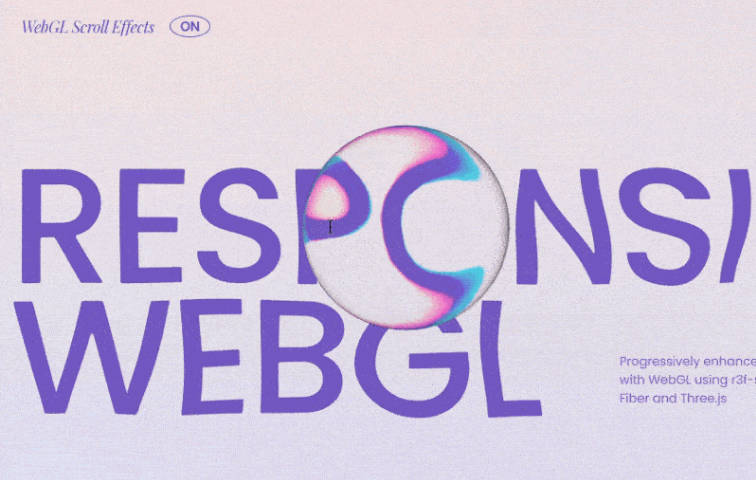react-ogl
Declaratively create scenes with re-usable OGL components that have their own state and effects and can tap into React’s infinite ecosystem.
Installation
npm install ogl react-ogl
What is it?
react-ogl is a barebones react renderer for ogl with an emphasis on minimalism and modularity. Its reconciler simply expresses JSX as ogl elements — <mesh /> becomes new OGL.Mesh(). This happens dynamically; there’s no wrapper involved.
How does this compare to @react-three/fiber?
react-ogl is a complete re-architecture of @react-three/fiber with:
- no defaults; you have complete control. No default renderer, camera, etc. For library/engine authors, this allows components to be completely transformative of rendering behavior and API. But this freedom leads to boilerplate. For both users and authors, there are —
- extendable helpers; react-ogl exports helper components and hooks for both web and native with an API familiar to @react-three/fiber, but these helpers are also modular. This enables you to change or extend rendering behavior and API while maintaining interop with the react-ogl ecosystem.
The API is the same as @react-three/fiber, but react-ogl is completely extensible.
What does it look like?
The following takes complete control and declaratively renders a mesh that can react to state.
import * as OGL from 'ogl'
import { createRoot } from 'react-ogl'
// Init rendering internals
const renderer = new OGL.Renderer({ canvas })
const camera = new OGL.Camera()
const scene = new OGL.Transform()
// Or you can use our own internals. This will also set up a render loop.
// const { root, renderer, camera, scene } = createInternals(camera, config)
// Set initial size
renderer.setSize(window.innerWidth, window.innerHeight)
camera.perspective({ aspect: window.innerWidth / window.innerHeight })
// Create root
const root = createRoot(canvas, { renderer, camera, scene })
root.render(
<mesh>
<box args={[{ width: 1.5, height: 1.5, depth: 1.5 }]} />
<program
vertex={`
attribute vec3 position;
attribute vec3 normal;
uniform mat4 modelViewMatrix;
uniform mat4 projectionMatrix;
uniform mat3 normalMatrix;
varying vec3 vNormal;
void main() {
vNormal = normalize(normalMatrix * normal);
gl_Position = projectionMatrix * modelViewMatrix * vec4(position, 1.0);
}
`}
fragment={`
precision highp float;
uniform vec3 uColor;
varying vec3 vNormal;
void main() {
vec3 normal = normalize(vNormal);
float lighting = dot(normal, normalize(vec3(10)));
gl_FragColor.rgb = uColor + lighting * 0.1;
gl_FragColor.a = 1.0;
}
`}
uniforms={{
uColor: { value: new OGL.Color(0xf5ce54) },
}}
/>
</mesh>,
)
// Render to screen
renderer.render({ scene, camera })
react-ogl itself is super minimal, but you can use the familiar @react-three/fiber API with some helpers targeted for different platforms:
Usage with react-dom
This example uses create-react-app for the sake of simplicity, but you can use your own environment or create a codesandbox.
# Create app
npx create-react-app my-app
cd my-app
# Install dependencies
npm install ogl react-ogl
# Start
npm run start
Inside of our app, we can use the same API as @react-three/fiber but with OGL elements and methods.
import * as OGL from 'ogl'
import { useRef, useState } from 'react'
import { useFrame, Canvas } from 'react-ogl/web'
import { render } from 'react-dom'
const hotpink = new OGL.Color(0xfba2d4)
const orange = new OGL.Color(0xf5ce54)
const Box = (props) => {
const mesh = useRef()
const [hovered, setHover] = useState(false)
const [active, setActive] = useState(false)
useFrame(() => (mesh.current.rotation.x += 0.01))
return (
<mesh
{...props}
ref={mesh}
onClick={() => setActive((value) => !value)}
onPointerOver={() => setHover(true)}
onPointerOut={() => setHover(false)}
>
<box
args={[
active
? { width: 1.5, height: 1.5, depth: 1.5 }
: { width: 1, height: 1, depth: 1 },
]}
/>
<program
vertex={`
attribute vec3 position;
attribute vec3 normal;
uniform mat4 modelViewMatrix;
uniform mat4 projectionMatrix;
uniform mat3 normalMatrix;
varying vec3 vNormal;
void main() {
vNormal = normalize(normalMatrix * normal);
gl_Position = projectionMatrix * modelViewMatrix * vec4(position, 1.0);
}
`}
fragment={`
precision highp float;
uniform vec3 uColor;
varying vec3 vNormal;
void main() {
vec3 normal = normalize(vNormal);
float lighting = dot(normal, normalize(vec3(10)));
gl_FragColor.rgb = uColor + lighting * 0.1;
gl_FragColor.a = 1.0;
}
`}
uniforms={{
uColor: { value: hovered ? hotpink : orange },
}}
/>
</mesh>
)
}
render(
<Canvas camera={{ position: [0, 0, 8] }}>
<Box position={[-1.2, 0, 0]} />
<Box position={[1.2, 0, 0]} />
</Canvas>,
document.getElementById('root'),
)
Usage with react-native
This example uses expo-cli for the sake of simplicity, but you can use your own barebones setup if you wish.
# Install expo-cli, this will create our app
npm install expo-cli -g
# Create app and cd into it
expo init my-app
cd my-app
# Install dependencies
npm install ogl react-ogl
# Start
expo start
Inside of our app, you can use the same API as web while running on native OpenGLES — no webview needed.
import * as OGL from 'ogl'
import { useRef, useState } from 'react'
import { useFrame, Canvas } from 'react-ogl/native'
import { registerRootComponent } from 'expo'
const hotpink = new OGL.Color(0xfba2d4)
const orange = new OGL.Color(0xf5ce54)
const Box = (props) => {
const mesh = useRef()
const [hovered, setHover] = useState(false)
const [active, setActive] = useState(false)
useFrame(() => (mesh.current.rotation.x += 0.01))
return (
<mesh
{...props}
ref={mesh}
onClick={() => setActive((value) => !value)}
onPointerOver={() => setHover(true)}
onPointerOut={() => setHover(false)}
>
<box
args={[
active
? { width: 1.5, height: 1.5, depth: 1.5 }
: { width: 1, height: 1, depth: 1 },
]}
/>
<program
vertex={`
attribute vec3 position;
attribute vec3 normal;
uniform mat4 modelViewMatrix;
uniform mat4 projectionMatrix;
uniform mat3 normalMatrix;
varying vec3 vNormal;
void main() {
vNormal = normalize(normalMatrix * normal);
gl_Position = projectionMatrix * modelViewMatrix * vec4(position, 1.0);
}
`}
fragment={`
precision highp float;
uniform vec3 uColor;
varying vec3 vNormal;
void main() {
vec3 normal = normalize(vNormal);
float lighting = dot(normal, normalize(vec3(10)));
gl_FragColor.rgb = uColor + lighting * 0.1;
gl_FragColor.a = 1.0;
}
`}
uniforms={{
uColor: { value: hovered ? hotpink : orange },
}}
/>
</mesh>
)
}
const App = () => (
<Canvas camera={{ position: [0, 0, 8] }}>
<Box position={[-1.2, 0, 0]} />
<Box position={[1.2, 0, 0]} />
</Canvas>
)
registerRootComponent(App)



